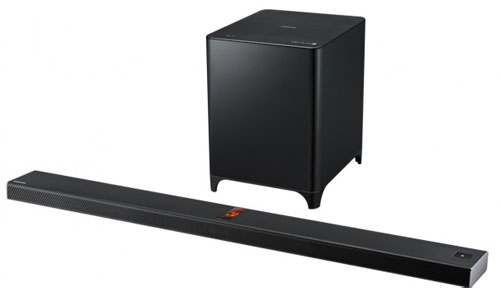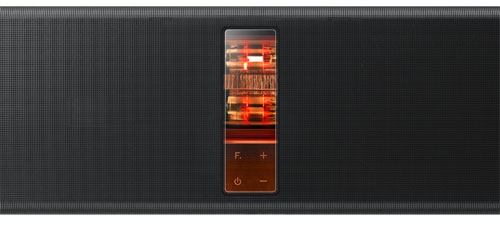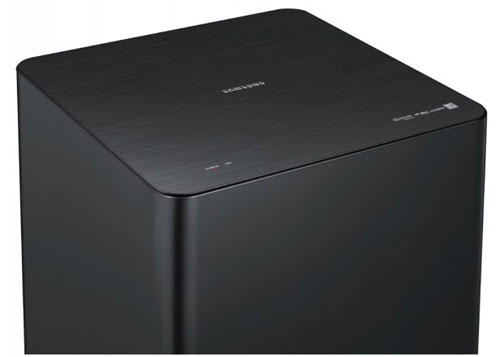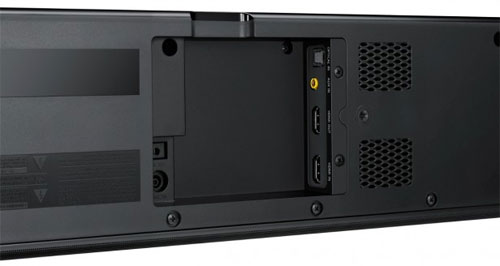It’s hard not to get excited when you’re reviewing a company’s flagship product – after all, the flagship should be the cream of the crop, the best of the best. Today we’re looking at Samsung’s top of the line soundbar: the HW-F850. After being very impressed with the Korean brand’s step-down HW-F751 and HW-F551 models, let’s see if the HWF850 lives up to its flagship status.

Samsung has certainly set the bar high in terms of the styling of its soundbars, and the F850 doesn’t disappoint. Straight out of the box we instantly preferred the black finish, having only seen the silver finish on the previous two models. Upon holding the main unit (weighing in at 4kg), it just felt like a quality product. The beautiful sleek design is once again finished in perforated aluminium, with those exposed valves shining through a small window in the middle. Seated below the valves are touch-sensitive buttons (including volume, power and function controls) and our favourite feature – an OLED display which is tucked away beneath the perforated mesh. All other features can be accessed via Samsung’s remote which ships with the HW-F850. The soundbar measures just over 46 inches, and so is perfect for 55-inch or larger TVs.

The bar itself can be placed flat or wall-mounted, and comes with the same positional sensor that’s found on the HW-F751. For those not familiar with the technology, it’s a great feature that automatically detects which way the soundbar is positioned and reconfigures the sound to output correctly. Another cool fact is that whichever way the bar is placed, the OLED display also recognises this. Placed on its back it appears on the thin edge on the front, and when placed upright it appears to the left of the valves and touch sensitive panel. Finishing off this stunning looking soundbar are two mirrored panels that grace each end. If we’re just rating based on the looks of the Samsung HW-F850, it would be “Reference Level” – it’s simply that gorgeous!

We’ve been a little disappointed with the appearance of the subwoofers included with Samsung soundbars so far, but we’re pleased to report that the HWF850’s subwoofer is a huge improvement. Again, the black finish really helps but it just looks and feels like a more premium product than the subs that came with the HWF751 and HWF551. At 10.5kg, it’s been beefed up and comes with an 8-inch down-firing speaker instead of the 6.5-inch driver found in the sub of the HW-F751. It’s active and wireless with a linked ID pre-set in the factory, and should connect as soon as the unit is switched on. On our review sample, it connected seamlessly, but if it doesn’t connect the first time, it can easily be reset manually.

The Samsung HW-F850 comes with an aux in, optical in, HDMI in, HDMI out, ARC (audio return channel), and an auto-calibration input (ASC). On the top of the bar there is also a USB slot which will play AAC, MP3, WAV, WMA, OGG, and FLAC files from your USB stick. There is also a NFC (near field communication) panel at the far right of the soundbar. Holding your NFC device near it will make a instant connection.
Samsung HDTV owners can connect their TV wirelessly to the F850 sound bar via Bluetooth with the SoundShare feature. For anyone who doesn’t own a Samsung telly, check your TV to see if you have an HDMI input labelled ARC on it. ARC stands for audio return channel, and is an excellent tool for using your TV to output the audio to the soundbar. Connect your Blu-ray or DVD player to the soundbar, and then use an additional HDMI cable to output into the ARC HDMI on your display. Then connect any additional devices to your television, and let the TV via the ARC HDMI switch the sources and output the correct audio to the soundbar. It’s a real shame, however, that there isn’t a second HDMI input – especially at this price point – as however good the ARC feature is, if there are more sources that need to be connected, it could cause issues not having that second HDMI input.
Once connected and switched on, we ran the auto calibration system. It’s worth pointing out that some of the test tones can be quite piercing so you might want to leave the room while the auto calibration does its thing! Again it’s really important to try to place the mic as close to ear height in your listening position as possible. This will always make for a more accurate calibration. Like all auto calibrations, from our experience, the subwoofer level is always set too hot, and this was the case with the Samsung HWF850. On the plus side, there is a separate volume control for the sub, but there isn’t a separate channel level volume for the bar itself, so getting a spot-on accurate blend between sub and speaker isn’t going to happen – but it was close.
In all 5.1 systems you have separate channel level controls for all speakers, allowing you to match all speakers to 75dB (the reference level for calibrating home cinema systems) using a sound level meter. However, with soundbars there isn’t a separate channel level, only an overall volume level: so how do you test if the soundbar and sub are balanced at 75dB? The only way to do it is to play some pink noise reference tones similar to the tones you hear from the auto calibration, and adjusting the overall volume to output 75dB on a sound level meter. So with our trusty RadioShack meter we played some reference pink noise and adjusted the master volume until it reached 75dB – in our case the volume was at 22 on the OLED display. Now we played the same reference tone through the sub at the same volume, and the meter read 87dB so they clearly were not balanced. Taking the subwoofer level down to it’s max of -6 got us to 79-80dB, so we were closer, but we still didn’t have a perfect balance between soundbar and sub. So how does this translate to real-world listening? Some users like to run their mains at 75dB and their sub hotter at 77-78dB, so with the HW-F850 subwoofer volume at -6 with a decibel reading of 79-80 it should sound pretty well-balanced.
We love the campus scene from The Incredible Hulk – it’s a great reference scene as it has plenty of bass, great surrounds, and plenty of mid and high detail. It’s also a great test for too much bass, as details such as those high frequency sounds of glass shattering from the car window are lost by bloated bass. Playing the scene with the bass volume at 0, with the ASC calibrated setting on, it was obvious from the outset that there was far too much bass, muddying fine detail. Playing the same scene with the subwoofer at -6 was a much more accurate representation of the sound mix, providing a much tighter bass with no loss of those fine details buried in the soundtrack.
However, as always it boils down to the old debate of reference versus preference. Some people like loads of heavy bass on their soundtracks, and others just don’t. The other important factor is that this setting relates to our listening environment. Just like you can’t enter TV calibration settings posted on the internet and expect accurate results, the same applies with audio. Subwoofer placement is crucial before even running the calibration – we explained how to do this yourself in our previous review of Samsung’s step-down HW-F751 soundbar.
What we’re trying to say is: don’t expect to set the HW-F850 up in your room, run the calibration, set the sub to -6 and expect it to sound balanced. It did in our listening room once we’d found the right spot for it, but it’s highly unlikely that it’ll do the same in your room. If you have a sound meter and access to test tones, try what we did. If not, let the calibration do its thing, then go back with a movie scene you’re familiar with, listen to whether the bass is bloated or too full, and finetune by ear. In fact, in the end, we wanted just a tad more bass so we increased the sub volume to -4. You might run the calibration and love the sound with the sub at 0. If so, perfect, but we here at HDTVTest like to tweak everything, and so couldn’t help but run some tests. We were glad we did because once we obtained better balance, the result was a joy to listen to.
Having set the Samsung F850 up, and achieved a greater balance between sub and soundbar, real-world listening was a triumph. We couldn’t wait to try out the chase and Batwing sequence from The Dark Knight Rises on the HW-F850, as on previous Samsung soundbars we’ve tested, this scene tripped up the subwoofers of both the HW-F751 and HW-F551, causing them to rattle. We’re pleased to report that this wasn’t the case with the HW-F850 whose beefed-up subwoofer handled low-end frequencies expertly. In fact the whole scene was presented superbly, offering up a wide soundstage with huge dynamic range. There’s a fantastic separation of sound and effects across the whole soundstage, and dialogue was centred and crystal clear.
It’s also worth mentioning that we much preferred the sound of the HWF850 in its upright position rather than flat on its back. The only downside to this was that when watching movies in a dark room, the glow of the valves could be quite distracting. However, a small piece of black card and some Blu-Tack worked wonders.
The Samsung HW-F850 comes loaded with various sound processing effects, including “Music“, “Drama“, “Cinema“, “Sports“, “Games“, and “Off” which is the original sound with no added effects. We listened to all of them, and thought that the HW-F850 sounded best with no added effects, so we recommend turning them off. This also relates to the [3D Sound Plus] feature – when engaged this had a detrimental echo effect to the sound, so we once again chose to turn this off.
As impressive as the Samsung F850 was with movies, its musical performance was the real star of the show for us. Music reproduction was sublime on the HW-F850. We found ourselves totally captivated by the smooth, warm presentation of the recordings we fed through the soundbar. Female vocals in particular sounded great on the Samsung, and the whole soundstage sounded almost analogue-like – free from any harsh limitations. This beautiful sound is thanks to the valve amplification which drives an impressive 4-way, six-speaker layout that spans the length of the soundbar. We found ourselves revisiting our favourite recordings with new life breathed into them – listening to music on the HWF850 was a real revelation.
The Samsung HW-F850 is not cheap, but it’s one of the best soundbars we’ve reviewed so far, along with the Philips Fidelio HTL9100. At a current street price of £799, it’s £100 more expensive than the Philips, but that extra outlay will get you the best soundbar we’ve tested thus far for music playback, delivering a stunning reproduction of various music sources. The Philips has the edge in movie playback owing to its detachable surround speakers, but it’s a very small advantage as the Samsung’s handling of soundtracks is at times absolutely breathtaking for a 2.1 system. Taking everything into account, we have no reservations in giving the HW-F850 a thoroughly deserved “Highly Recommended” award.
